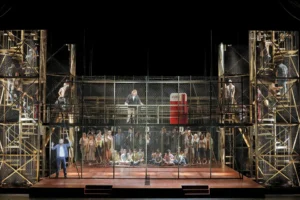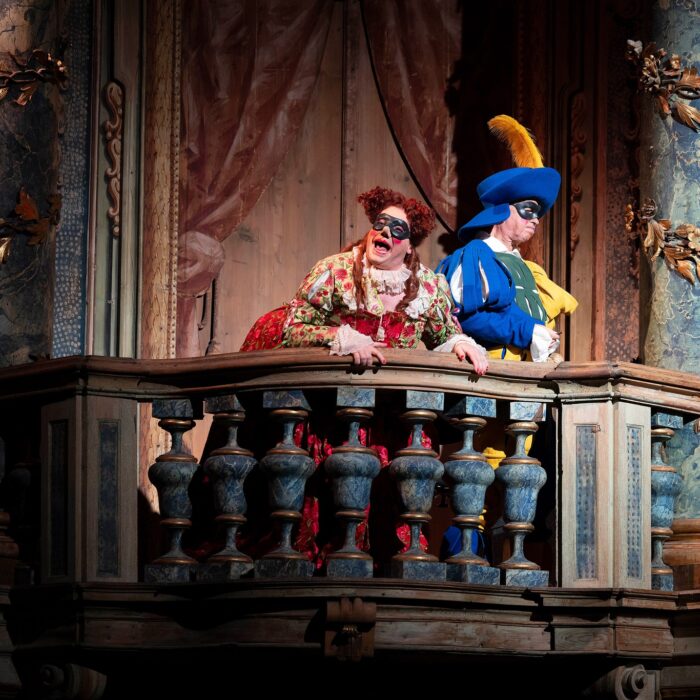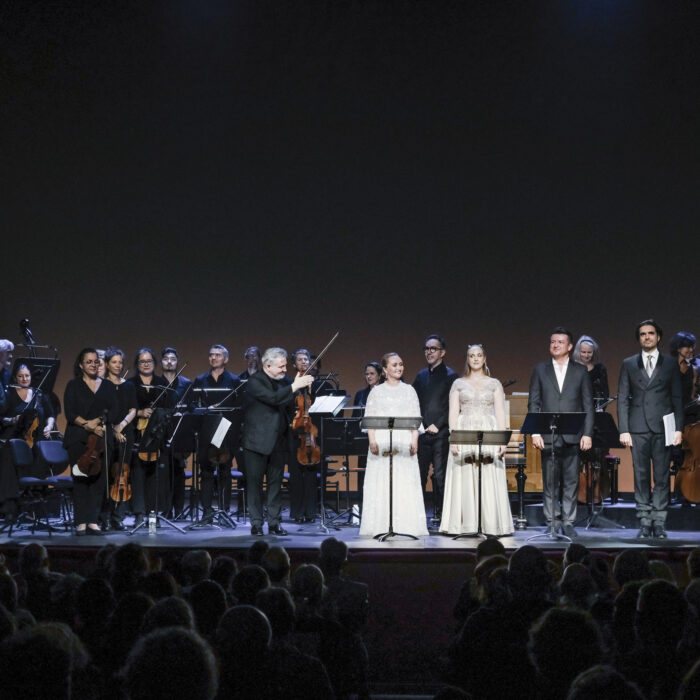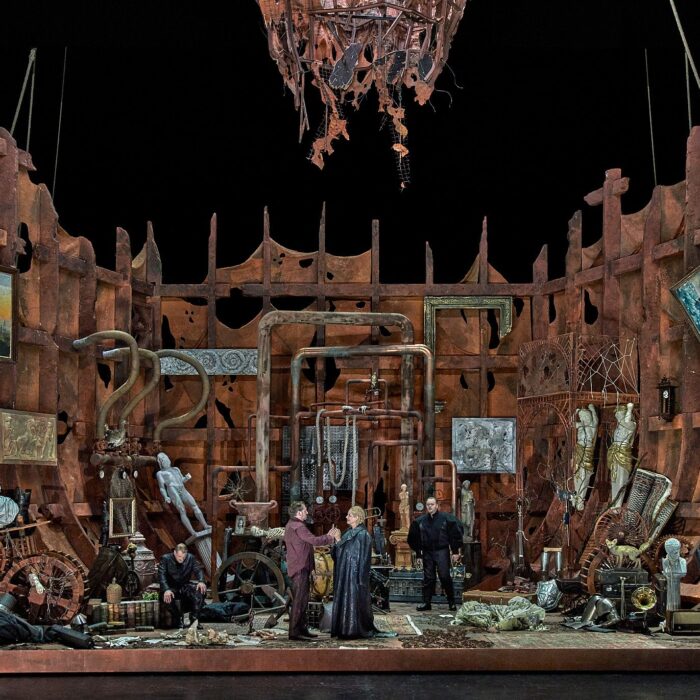
San Francisco Opera 2025-26 Review: Dead Man Walking
By Lois Silverstein(Photo:
“Dead Man Walking” by Jake Heggie was twenty-five years old on Sunday, September 14th. In San Francisco, its anniversary was celebrated by the opening of a production, one of the 80 productions worldwide, with the composer, Jake Heggie there to receive the San Francisco Opera Medal, and Sister Helen Prejean, from whose book the opera arose, and retold in the libretto, by noted writer Terence McNally, was there to receive gratitude for its telling and numerous retellings. While the opera tells its weighty tale of another time and another place, to San Francisco it seemed more than pertinent to all too recent events that have transpired in America. It was evident the audience was lifted from that despair by the story of Joseph De Rocher’s execution by the excellence of the production that left the opera house moved and provoked.
Cast Highlights
Jamie Barton, the brilliant mezzo-soprano sang Sister Helen with moving and penetrating thoughtfulness and humanity. From the outset, she sang with a focus that emphasized her struggle about meeting a criminal on death row and her own conflicts about capital punishment. She kept this stance throughout. Sometimes her powerful voice seemed constrained although it almost always fit with the character and her mission. As Sister Helen, she showed her deeply suffering side and her religious conviction. The beauty and power of her voice kept the story vibrant and deeply evocative. What was particularly gripping in Barton’s performance was her thoughtfulness with Joseph, her constancy, her stability and her commitment to the love she bore him and which evoked from him at the end. No sentimentality here, just steady, present love. It was extremely touching.
Baritone Ryan McKinny was a steady and moving Joseph DeRocher. From the outside, a stubborn and biting hard-man who opened with defiance and a stance of get-me-out-of-here-or-get-out, to the vulnerable human being who finally admitted his guilt for murder and his plea for acceptance as he dies. He held his nerve, his voice and his posture. He never wavered. He did pushups on the eve of execution; he advised his younger brothers to take care of their mother after he no longer could; he looked at Sister Helen with love and compassion as he bled out his crime and seemingly accepted that he was a child of God, in Sister Helen’s words, anyway. He sang his way through our minds into our hearts. He carried the message. His voice was resonant and compelling, beautiful in its variety and humanity.
Soprano Susan Graham as De Rocher’s Mother performed with poignant and telling detail. In the original production, 25 years before, Graham played Sister Prejean. As the mother of three (four? – the script did not clarify where the son who was the accomplice to Joseph in the murder was when de Rocher went to his death) sons, her vulnerability, her sincerity, her genuine maternal love shone. Her voice was vulnerable and stunning. It soared, it came close, the intimacy of that relationship was evident from the get-go. She never lapsed from it. Her posture, her facial gestures, her physical presence captured the sorrow and the determination to give him courage and support as well as love as he faced his doom. Her interaction with Sister Helen was moving, as was Sister Helen’s with the father of the murdered girl. “Haven’t we all suffered enough?” she repeated, a motif which Heggie used throughout his choice for motives, haunting, and incisive. Like a needle, it penetrated in its simplicity.
The various soloists including Rod Gilfry as Owen Hart, Brittany Renee as Sister Rose, Raymond Aceto as the Warden, sang with intention and intensity, each fulfilling his or her part in the unfolding drama. The Chorus, directed by John Keene, amplified the story with apt power and attentiveness. They served a reality check of life in such a brutal situation and sang as real people, not simply as ancillary voices. These coalesced exceedingly well, neatly embodied, faithful to their roles. As a whole, the piece was a welcome collaboration. All who sang and performed in the work were unified in its transmission. It was a group effort that linked the audience into the process.
Production Details
The extraordinary collaborative nature of the production highlighted the afternoon. Director Leonard Foglia started with the raw, explosive scene of the murder of the two teenagers in garish red lights darting in the dark, studded with stars. Deep orchestral percussion highlighted the tension. No video or graphic depiction here, but the thing itself. It set the tone. This would be no intermediary between the story of guilt and redemption but the first of several dramatized moments of violence out of which the whole story of redemption arises.
The overall action centered on Angola and the Louisiana State Penitentiary. Set Designer Michael McGarty divided the stage into forcefields for the action, each one circumscribed as if it were a cage, each cage serving as a prison cell or a waiting area, or a setting for challenging confrontation, or introspection. Prison doors and gates rose and fell increasing tension. Movement from one quadrant to another did as well, keeping the whole situation alive and vigorous. The Chorus, directed by John Keene, performed as prisoners who inhabited these arenas, jeering, fighting, playing basketball, among others. This also enhanced the tension occurring in the main stage action. Only once, the second act scene between Sister Helen and Sister Rose, while effective and important in terms of the narrative their discussion flagged somewhat. Intensity fell into discussion and the sense of time passing got bogged down in words.
Light design by Brian Nason aptly highlighted the various dramatic moments, particularly during the Prologue and opening Scene of Act two, with its strong colors then notably at the opening when Joe, tattooed and in his boxer shorts and tee shirt, does pushups until the end, repetitively saying, “I ain’t sorry for a thing,” all the time being riven by guilt. So did the Las Vegas lights, the projections of Family portraits and the scene shots as Sister Helen traveled to Angola, created by Elaine J. McCarthy. The realistic and easily accessible costumes by Jess Goldstein, added to the strong sense of being there now.
Illuminating Music
Patrick Summers conducted the San Francisco Opera Orchestra with precision and power. The various colorations of mood and texture were both in the forefront and the background and are the notable aspects of Heggie’s score. Filled with motifs earmarking each character, one could easily follow the personality clashes and alignments. Further, with the duets and particularly the quartets in each act, one heard and felt the disparate points of view simultaneously. Conflict came through in harmonious fashion, rage and grief, disappointment and fear – Heggie touched each of them and we felt each one.
Here were multiple worlds, dark and less dark and ones in which the confusion that drove the situation unfolding right before us. It eschewed simplification. No one was free to peddle good in a human drama that was marked by blatant and cutting desires and dreams that life mortified. These could not be escaped, and Heggie made sure to guide us into their complexities with rich instrumental textures. Sister Helen herself was deeply pricked by anxiety and fear as she saw the truth of a young man gripped by pain beyond the obvious. Her compassion for him remained alive in music that was at the same time his anguish, for the whole situation which had been from the outset, “beyond” his control. The struggle was big and uncontainable, each character had to declare “I don’t know,” “you don’t know,” and “we don’t know.” Each person struggled to stop being a victim. How was that possible? Only rarely was there any disjointedness between the rich orchestral sound and the singers’ voices, although sometimes the text was covered. Overall this was not so.
Parallel were the struggles of Sister Helen who, while steady in her commitment, was challenged when seeing Joseph de Rocher unfortified by a faith that sustained her at her core, illustrating the struggle they both had as human beings. She asked and prayed, trying to align her belief with what the human institution she adheres to commit murder as an act of justifiable justice. In a sense, the lack of blind adherence was a testimony to her faith and to her conviction that not only sustained her through her part in the ordeal, but transferred to Joseph as he admitted his guilt and confessed his grief over it. It was a story of genuine transformation, although it was filled with pain. Further, as Joseph says, “you’re blaming me for killing and now what are you planning to do with me?”
The libretto by Terence McNally from Sister Helen Prejean’s book was masterful and has been praised from the first performance 25 years before. The story of Prisoner 95281 echoes several of our most pressing social issues today, from violence, capital punishment, to human despair. Here was opera on its toes. “Dead Man Walking:” Happy 25th Birthday.


